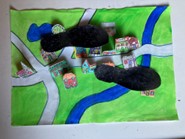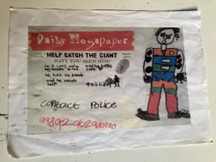
The author of THE GIANT FROM NOWHERE, Frances Dickens worked for 19 years as a primary school teacher, specialising in English as a second language and special educational needs. In this blog piece, Frances talks us through how the book works in action as an imaginative, fun way for children to develop empathy and an understanding of what inclusivity means, whilst acting out scenes, drawing, making a newspaper, maps and more.
How I came up with the Giant…
The Giant came into my mind whilst I was working as a primary school teacher in an educational priority school in London. I had studied drama in teaching, and drawing on this, I developed a story with the Giant with Reception, and Years 1 and 2.
WHY? Because I wanted to develop a story that demonstrated empathy and inclusivity that would be planted as seeds within the children and help them in their journey through life.
All the children became fully involved and participated successfully whether they were acting as villagers, or giants. The work they produced was differentiated according to their abilities, so that they felt pride in their work, whether it was through drawing or writing.
The final part of the Giant’s story brings all the children together in a celebration, and members of staff joined in. The Giant’s journey was meaningful, and best of all FUN! (There are Teaching Plans available online which will guide a teacher or carer through the different stages of the story).
Below is an example of how I worked with Tilly, a five-year-old on a one-to-one basis:
‘THE GIANT FROM NOWHERE’ – How to start?
I wanted to explain the difference between a village and a town, before reading the story. So I showed her pictures of a town, with lots of buildings, busy streets, cars, buses, everything Tilly was familiar with. I showed her pictures of a village. A river, a few houses and shops, animals in the fields, trees and a few cars, maybe a school, a police station, the doctor’s house. I suggested we could paint a picture of a village, about A2 size. We did and I put it up on the wall. This activity enabled Tilly to understand the difference through illustration.

Tilly went to bed. I then cut out two enormous footprints on black paper and stuck them on the painting.

The next day Tilly saw the painting and the footsteps. I acted surprised and asked her ‘Who has walked across your village?’ and said ‘It wasn’t me, and it can’t be you, because your footprints are too small.’
And then I began the story of ‘THE GIANT FROM NOWHERE.’
Tilly immediately understood what had happened when the Giant trampled on the village.
I suggested we pretend we were tiny villagers and had come home to find our damaged houses. I read a part of the story where villagers are complaining. I suggested we could pretend to be villagers. I started off using a tiny voice, ‘The Giant broke my windows, what did he do to your house Mrs. Tilly?’ I led the way using different voices to encourage her to join in and Tilly really enjoyed it.
I asked Tilly, ‘how do you think the villagers feel?’ – she said ‘angry’ and ‘sad’ which was good. I asked her how the Giant felt. She wasn’t sure. So I re-read part of the beginning. ‘Oh, he feels angry!’ she exclaimed. ‘Why?’ I asked her. ‘Because he can’t find anywhere to live. He’s too big,’ she said.
Getting creative: thinking up ways to catch the Giant
The story naturally takes you to trying to stop the Giant and catch him, but HOW?
So I asked Tilly, ‘How can we get the world to know we want to catch this Giant?’ ‘I don’t know,’ she said. So I explained about news. I showed her a newspaper. I explained that many people bought newspapers to find out what was happening in the world. I asked her ‘Do you think it would be a good idea to do a drawing of the Giant and ask a newspaper to put it on the front page. Many people will buy the newspaper and maybe they can help us find that Giant. What do you think Tilly?’ and Tilly thought it was a brilliant idea.
I suggested ‘We can make a newspaper to try and find that Giant, but before we do that, someone called a Reporter is coming to see you to ask you some questions.’ I explained that Reporters worked for newspapers and wrote the stories in newspapers. I read Page 11 and acted as a reporter, holding a notepad and writing down her answers.
After that and with the help of a newspaper template which comes with the story via a link, we made a newspaper and she drew and coloured the Giant.

I read page 14 where the police ask the villagers questions, and Tilly was eager to be interviewed, and to act as a police person. There is also a template for the police interview and a space to put a thumb print! She loved putting in a thumb print!
Well, when I read Page 14, Tilly learnt that the Giant had nothing to say to anyone. ‘Look at his picture Tilly,’ I said, ‘how do you think he is feeling.’ Tilly replied, ‘He looks so sad.’
‘Let’s pretend that I am the Giant, and you are asking me why I went to the village.’ So I put on a hat and sat hunched up in a corner, moaning, ‘Nobody understands me.’ I could see Tilly was a little stuck, so I looked up and asked her, ‘Why have you come to see me?’ this to encourage her to participate, and it worked.
I asked her, ‘Now can you tell me why he is feeling sad?’ And she did, ‘he is lonely, and he is too BIG!’
Acting out a court scene – with toys as witnesses!
After reading page 18, I had to explain to Tilly why the Giant was taken to see a Judge and what that meant. This involved explaining what witnesses were. I explained they were the villagers who saw what he had done to their village. They had to tell the Judge and the Judge had to pass a sentence.
Another way of explaining this is to sit a circle of toys on a sofa, and act as a Judge. The guilty character was a puppet called Billy. He had thrown all the toy cars on the floor. The toys were the witnesses. I used one toy after another to give evidence, ‘Billy threw the cars on the carpet!’ etc., then asked Tilly to pretend and give evidence. It worked. I asked what the Judge would say. Tilly thought about it, and said, ’Billy should put all the cars away.’ ‘That’s a really good idea Tilly,’ I said.
So turning to the story I said, let’s see what the Judge has to say. We continued reading the story, where the final sentence is passed, that the Giant can live in a field near the village, but must mend everything he has broken.
I asked Tilly how she thought the Giant was feeling now. ‘He is happy because he has somewhere to live,’ she said. So how do the villagers feel about the Giant living near their village? (I had read the part of the story where the Giant is mending their houses, and making toys for the children.) ‘They love him because he is mending things and making toys,’ she said.
Empathy and Inclusivity
I know that Tilly understood the different feelings experienced by the villagers, and the Giant. The main reason for enabling her to understand was to involve her in the story, to take part, many parts as villagers, reporters, witnesses, and more.
THE GIANT FROM NOWHERE is a perfect story for interactive participation. Children love to take part and be allowed to contribute. This enables the development of empathy and inclusivity in a meaningful way and will help them on their journey through life.
The Giant from Nowhere by Frances Dickens is available now.
If you liked this article, why not join our mailing list to receive exclusive content and discounts? Sign up to the mailing list here.